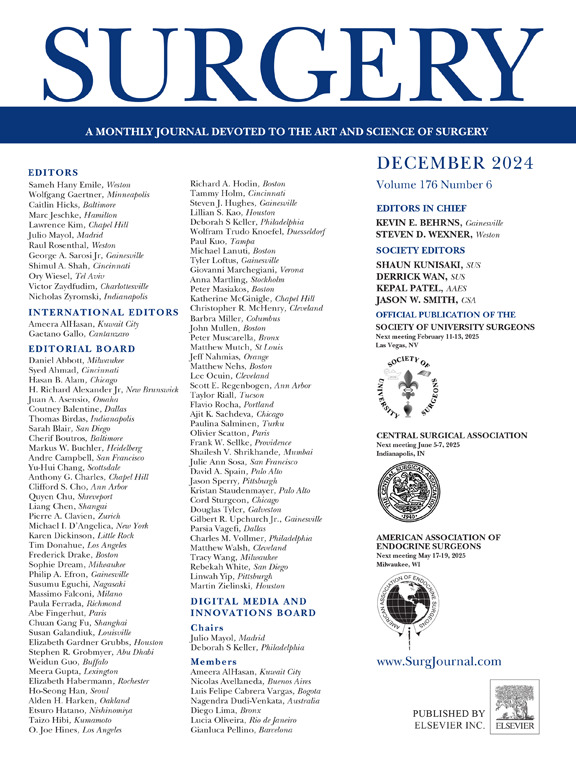The minimum number of lymph node retrieval in gastric cancer patients after neoadjuvant therapy: An international multi-institute cohort study
IF 3.2
2区 医学
Q1 SURGERY
引用次数: 0
Abstract
Background
The minimum number of retrieved lymph nodes for radical gastrectomy after neoadjuvant therapy remains controversial. The objective of this study was to determine the minimum threshold for retrieved lymph nodes in patients with gastric cancer after neoadjuvant therapy to accurately evaluate staging and prognosis.
Methods
Multivariate models were employed to investigate the correlation between the number of retrieved lymph nodes and survival outcomes and stage migration. The hazard ratio curves for each retrieved lymph node count compared with 1 retrieved lymph node (as a reference), including overall survival and disease-specific survival, were fitted using a LOWESS smoother, and the structural break points were determined by Chow test.
Results
This international multicenter study analyzed the clinicopathological data of 2,490 patients with gastric cancer who underwent gastrectomy after neoadjuvant therapy. The median follow-up period for the overall population was 90.0 months, with a median of 22 retrieved lymph nodes. The study demonstrated that a greater number of retrieved lymph nodes was linked to a greater probability of detecting positive lymph nodes (odds ratio, 1.005; P = .030) as well as improved overall survival and disease-specific survival (overall survival: hazard ratio, 0.988; P < .001 and disease-specific survival: hazard ratio, 0.987; P < .001). The cutoff point analysis identified 24 as the minimum number of retrieved lymph nodes. The 5-year overall survival rate was significantly greater in the group with ≥24 retrieved lymph nodes (46.0%) compared with the group with 16–23 retrieved lymph nodes (35.3%) and the group with <16 retrieved lymph nodes group (29.3%) (P < .001). Similar trends were observed with regard to disease-specific survival. The time-dependent area under the curve analysis revealed that the group with ≥24 retrieved lymph nodes exhibited superior predictive performance for overall survival and disease-specific survival compared to the group with <24 retrieved lymph nodes, on the basis of ypN staging (overall survival: time-dependent areas under the receiver operating characteristic curve≥24, 0.71 vs time-dependent areas under the receiver operating characteristic curve<24, 0.67; disease-specific survival: time-dependent areas under the receiver operating characteristic curve≥24, 0.72 vs time-dependent areas under the receiver operating characteristic curve<24, 0.68).
Conclusion
The minimum number of retrieved lymph nodes for evaluation prognosis and reducing stage migration in patients with gastric cancer who undergo radical gastrectomy after neoadjuvant therapy was 24.

新辅助治疗后胃癌患者淋巴结回收的最小数量:一项国际多机构队列研究
背景:新辅助治疗后根治性胃切除术的最小淋巴结数量仍存在争议。本研究的目的是确定胃癌患者新辅助治疗后淋巴结回收的最小阈值,以准确评估分期和预后。方法采用多变量模型探讨淋巴结清扫数与生存结局及分期转移的相关性。每个检索到的淋巴结计数与1个检索到的淋巴结(作为参考)的风险比曲线,包括总生存期和疾病特异性生存期,使用LOWESS平滑器进行拟合,并通过Chow检验确定结构断点。结果这项国际多中心研究分析了2490例胃癌患者在新辅助治疗后行胃切除术的临床病理资料。总体人群的中位随访期为90.0个月,中位淋巴结为22个。该研究表明,更多的淋巴结回收与更大的检测阳性淋巴结的可能性相关(优势比,1.005;P = 0.030)以及总生存期和疾病特异性生存期的改善(总生存期:风险比,0.988;P & lt;0.001和疾病特异性生存率:风险比0.987;P & lt;措施)。截止点分析确定24个为最小淋巴结数量。≥24个淋巴结组的5年总生存率(46.0%)明显高于16 ~ 23个淋巴结组(35.3%)和16个淋巴结组(29.3%)(P <;措施)。在疾病特异性生存率方面也观察到类似的趋势。曲线下的时间依赖面积分析显示,在ypN分期的基础上,与淋巴结≥24个的组相比,淋巴结≥24个的组对总生存和疾病特异性生存的预测性能更好(总生存:患者工作特征曲线下的时间依赖面积≥24,0.71 vs患者工作特征曲线下的时间依赖面积,0.67;疾病特异性生存:患者工作特征曲线下时间依赖面积≥24,0.72 vs患者工作特征曲线下时间依赖面积[lt;24, 0.68]。结论胃癌根治术患者新辅助治疗后最小淋巴结清扫数为24个,可用于评价预后及减少分期转移。
本文章由计算机程序翻译,如有差异,请以英文原文为准。
求助全文
约1分钟内获得全文
求助全文
来源期刊

Surgery
医学-外科
CiteScore
5.40
自引率
5.30%
发文量
687
审稿时长
64 days
期刊介绍:
For 66 years, Surgery has published practical, authoritative information about procedures, clinical advances, and major trends shaping general surgery. Each issue features original scientific contributions and clinical reports. Peer-reviewed articles cover topics in oncology, trauma, gastrointestinal, vascular, and transplantation surgery. The journal also publishes papers from the meetings of its sponsoring societies, the Society of University Surgeons, the Central Surgical Association, and the American Association of Endocrine Surgeons.
 求助内容:
求助内容: 应助结果提醒方式:
应助结果提醒方式:


